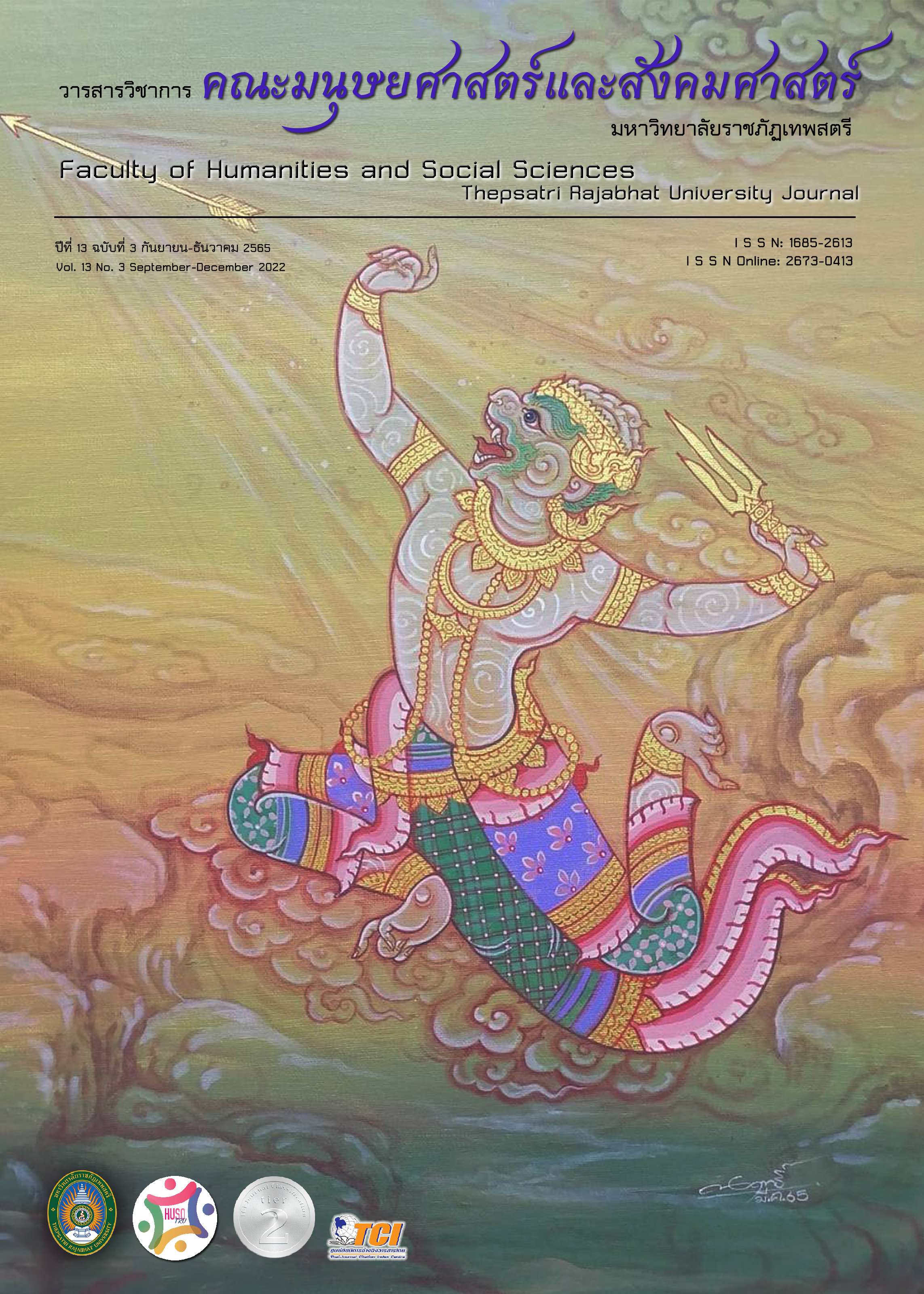Knowledge of Thai Composition: Subsak Duriyapaneet
Main Article Content
Abstract
This research aims to study the knowledge of Thai compositions by Mr. Subsak Duriyapaneet. The researcher found that Mr.Subsak Duriyapaneet is an important figure who retained the knowledge of various aspects of the "Duriyapaneet" family, especially the knowledge of Thai compositions that should be studied very seriously. The researcher chose the research tool, which is an unstructured interview. It consisted of 4 aspects: 1. knowledge of Thai compositions, 2. experience in Thai compositions and Thai compositions, 3. principles of Thai compositions, and 4. Thai compositions strategies. The researcher collected data from documents, textbooks, related research, note taking from interviews of the population and target informants. Data obtained were separately analyzed as to visualize them into subsections, to verify and reaffirm its validity. Then, data were analyzed all the subsections as to give an overview. Data were also synthesized qualitatively. The result discussion was descriptively composed, and data on knowledge of Thai compositions were reorganized.
The results showed that: 1. knowledge of Thai compositions is accumulated from the experiences and implementation, 2. the experience in Thai compositions and Thai composition works can be traced back in 1978 up until the present day. His most recent work is the solo composition of the song Ahia Sam Chan, which winning 2 instruments awards including Kong Wong Yai and Ra Nad Tum, 3. the principles of Thai song compositions are "9 KNOWs", including: 1) Know the principles, 2) Know the overblown face 3) Know the gong hand 4) Know the sound ladder 5) Know the accent 6) Know the reason 7) Know yourself 8) Know the instrumentalist 9) Know the listeners, 4. Thai compositional strategies are to expand the principles into exemplification of melody composed to illustrate the reasons and strategies chosen in each melody.
Downloads
Article Details

This work is licensed under a Creative Commons Attribution-NonCommercial-NoDerivatives 4.0 International License.
The content and information presented in articles published in the Academic Journal of the Faculty of Humanities and Social Sciences, Thepsatri Rajabhat University, are solely the opinions and responsibilities of the respective authors. The editorial board of the journal neither necessarily agrees with nor assumes any responsibility for such content in any manner whatsoever.
All articles, information, content, and images published in the Academic Journal of the Faculty of Humanities and Social Sciences, Thepsatri Rajabhat University, are the copyright of the journal. Any person or organization wishing to reproduce, disseminate, or otherwise utilize all or any part thereof must obtain prior permission from the Academic Journal of the Faculty of Humanities and Social Sciences, Thepsatri Rajabhat University.
References
ณรงค์ชัย ปิฎกรัชต์. (2561). แนวคิดในการวิจัยเชิงคุณภาพและแบบผสม. เอกสารประกอบการบรรยาย รายวิชา MSMS 702 ระเบียบวิธีวิจัยเชิงคุณภาพและแบบผสม. หลักสูตรปรัชญาดุษฎีบัณฑิต สาขาวิชาดนตรี วิทยาลัยดุริยางคศิลป์ มหาวิทยาลัยมหิดล. (เอกสารสำเนา).
พูนพิศ อมาตยกุล. (2562). สุนทรียะ - ความงามกับดนตรีไทย. เอกสารประกอบการสอนรายวิชา รหัสวิชา403105 วิชาสุนทรียศาสตร์ทางดุริยางคศิลป์ไทย หลักสูตรศิลปมหาบัณฑิต สาขาวิชาดุริยางคศิลป์ไทย สถาบันบัณฑิตพัฒนศิลป์ (รวมเล่มสำเนา). กรุงเทพฯ: สำนักพิมพ์สถาบันบัณฑิตพัฒนศิลป์.
มานพ วิสุทธิแพทย์. (2533). ดนตรีไทยวิเคราะห์. กรุงเทพฯ: โรงพิมพ์ชวนพิมพ์.
ศุภณัฐ นุตมากุล. (2563). การประชันวงปี่พาทย์บ้านดุริยประณีต. วิทยานิพนธ์ปริญญามหาบัณฑิต สถาบันบัณฑิตพัฒนศิลป์.
บุคลานุกรม
ชูเกียรติ วงฆ้อง. (2556). การประพันธ์เพลงไทย. (เทปเสียง).
นรวิชญ์ รุ่งเรือง. (2565, มีนาคม 30). นิสิตจุฬาลงกรณ์มหาวิทยาลัย. สัมภาษณ์.
ปิติกร เทียนจีน. (2565, มีนาคม 30). ข้าราชการครูวิทยาลัยนาฏศิลป จันทบุรี. สัมภาษณ์.
ภาคภูมิ รุ่งเรือง. (2565, มีนาคม 30). เครือญาติสายตระกูลดุริยประณีต. สัมภาษณ์..
วุฒิพงศ์ เถาลัดดา.(2565, มีนาคม 30). พนักงานธนาคารกรุงเทพ. สัมภาษณ์.
สืบศักดิ์ ดุริยประณีต. (2565, มีนาคม 27). ครูดนตรีไทยอาวุโส ข้าราชการบำนาญกรมประชาสัมพันธ์. สัมภาษณ์..


